and
When tea was first introduced into England in the 1700's, it was very expensive. Only the court of the king and the very wealthy noblemen could afford it. After decades the price declined substantially, but for a long time it was primarily a drink for the nobility.
The top auction houses sometimes offer sets of silver flatware which were specifically designed for use at "tea time". These equipage sets often contain different utensils which were necessary for the proper serving of tea.
The complete sets are very rare and very very expensive. But through my travels I have found a few pieces which were probably from these sets at some time in the past. It was quite common for sets of silver to be "broken up" by different generations when the owner died and the pieces were distributed to the heirs. Consequently collectors can find the "odd" spoon.
I am not an avid collector nor an expert in old silver, and would appreciate any help that any one wishes to give me in identifying these pieces. The statements are based upon pictures which I have seen in books and high end catalogs.

The mote spoon (5.75" 146mm) is an unusual piece with a pointed edge which was designed to clear the tea pot when tea leaves blocked the opening screen. The spoon bowl was designed to remove the small floating pieces of tea leaf or foreign matter (motes) that might be found in the cup. The spoons can be dated by the shape of the perforations in the bowl.
This spoon contains only one mark (not at all unusual for these pieces)
The mark is hard to read but could be either "PH" or if viewed upside down "Hd". All of this is in an irregular shaped cartouche with devices above and below the letters.
This mark has now been tentatively identified as Houghton Perkins (1735-1778) of Boston and Taunton, Massachusetts. Perkins was a contemporary of noted Boston silversmith Paul Revere and is the son of Isaac Perkins (1676-1737) a very early colonist silversmith. This mark is a variation on his father's mark so it was probably made when he was an apprentice.
Based upon styling I would guess this piece is from the 1750's. (This turned out to be a very accurate guess)
Also the fact that this is an American colonist mote spoon rather than English makes it very rare. Of course if it had been a Revere, then it would have been much more valuable.
When tea was available it was not a "pure" product as to which we are now accustomed. The old tea leaves were often mixed with impurities (some of which might upset you if I specified them).
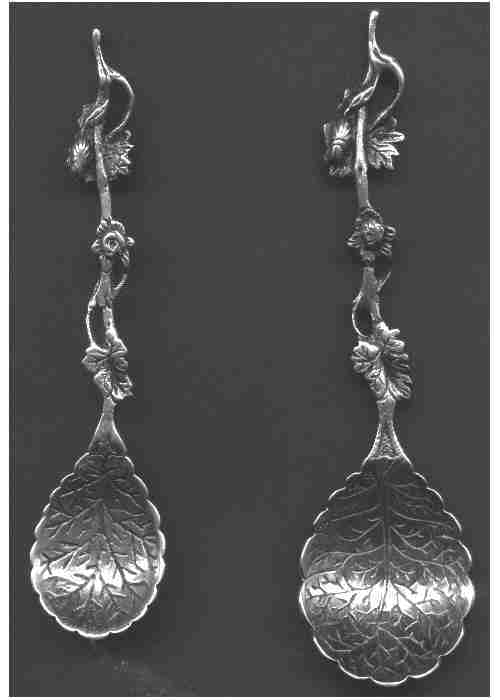

These three cast tea leaf spoons are probably from different sets. All are unmarked (which apparently is not unusual for these type of pieces). The design is carried over to the back. also note near the top appears a "ladybird" which has been incorporated in the design.
I would estimate that these are also from the 1750's
Note: I have seen silverplated replica's of these spoons and even a silver replica

This hand made server spoon with beautiful engraving on the handle and bowl features a 4-leaf clover finial "for luck" and has a complete set of the marks of Hester Bateman (London, 1798)
She is one of the best known female silversmiths in the world
I haven't been able to determine if the engraving is original to the spoon or if it is of later Victorian origin.
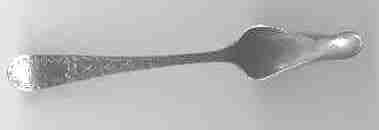
This old engraved English style pap spoon probably dates to the late 1790's and was probably made in one of the English provinces that did not have a hall marking office.
The marks are not full English marks, but they do contain a monarch head duty tax stamp
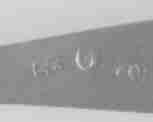

A classic old English style pap spoon. This spoon is hand made but the only mark is 0925. From this limited information I suspect that it is probably South American, and I would also suspect that it is 19th century. This style of spoon was made for several hundred years.
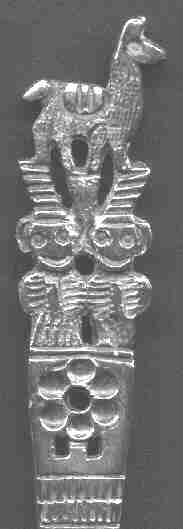
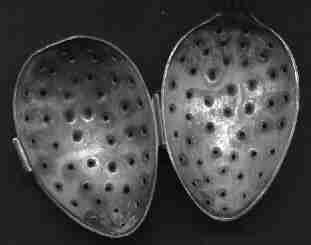
Unusual tea strainer souvenir spoon
This handmade Peruvian spoon features a llama above two stylized figures
The bowl is hinged and tea leaves were placed in the bowl which would then
be closed and "locked". I am unsure of the dating and the spoon is only marked
"900" which is also somewhat unusual in that silver from Peru is typically
sterling quality "925". I suspect that the spoon was probably made for someone
of Central European Descent.

This spoon and fork set are reproductions of a very rare mid eighteenth century English pattern called "whip" or "whiplash". This set was handmade in sterling silver by the American firm of Frank M. Whiting (1878 - 1896)
The only known examples of the English Whip pattern are six spoons belonging to the Victoria and Albert Museum.
Note: replica's have also been made be other companies

This is an example of "old english" bright cut engraving dated to 1788 by the marks. As you can see from the picture, this spoon has seen substantial use (note the bowl has been worn down). Silver was very expensive at this time, and it was not unusual to use a piece over and over again. Sometimes it pays to look into piles of "junk" spoons. I was able to buy this very old spoon for the whopping sum of $4.00 (not too bad for a 200+ year old antique--even if it is not in primo condition).

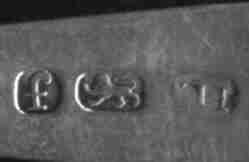
Notice the similarity in the engraving style between this spoon and the one shown above. The marks on this spoon are not complete. It appears to have a date mark, the sterling lion and a maker mark of "TI", but there is no city mark. The date mark is the same as Sheffield 1829. If we assume that is the correct date, it is interesting to note that the style had not changed substantially for almost 40 years. It is hard for us to understand that longevity when we see car models change every year, isn't it? This spoon is also engraved "M+S", I wonder if it were meant to be a marriage spoon?

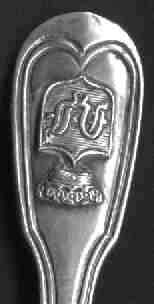
The French fiddle style of flatware was used circa 1825 in England but made an earlier presence on the European continent. untraced mark but probably northern France or nearby countries.

A large spoon in this style. I have not been able to trace the marks on this serving spoon. Spoons in this style were made thru the 1890's
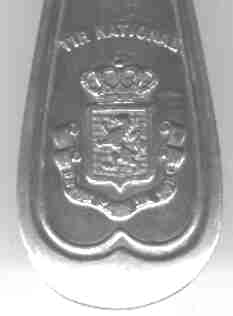
The back of the stem has this nice embossed picture of a crown marked "tri national". I have enlarged and rotated it so that it is easier for you to see.
I suspect that this spoon is of a later manufacture (1890"s)

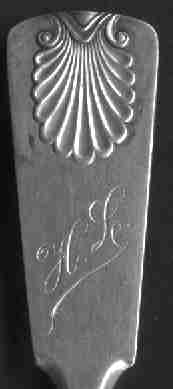
The fiddle and shell pattern was used circa 1850. There are many variations on both the fiddle and shell. It is best to consult a reference book to see all the possible variations. This serving spoon is from Finland.

This pointed end style was used circa 1800. It is often found engraved with bright cutting and many times it has initials, but this particular piece is plain. Untraced marks but probably from the Austria or Hungary area.

Very large (10.25" 260mm) fiddle pattern serving spoon from the 1780 - 1800 time period. The mark identifies it as being made by George Hutton (1729 - 1806) of Albany, New York. Note the extremely small shoulders which indicates that it is probably before 1800. The top is engraved with contemporary fancy intertwined initials which I think are "NR". Unfortunately this spoon has seen a lot of use as it is slightly worn and has minor damage in the bowl.
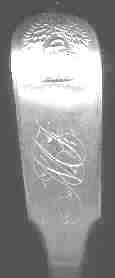
This is the tip of a handle of a nicely hand made creme ladle in the desireable "Sheath of Wheat" pattern. It also has an engraved fancy cypher "W" or "M" and was made by Everard Benjamin (between 1830 - 1840) of New Haven, Connecticut

I am unsure of the use of this very unusual hand made serving piece in the trailing vine pattern. The marks indicate that it was made by Henry Andrews of Boston, Mass. in the 1830's. I like the quality of the chasing in the handle and I also thought that the engraving in the bowl was rather unusual.

I am also unsure of the use of this very pretty engraved little fork which is made by the same silversmith

Unusual sugar crusher spoon. Apparently sugar did not come in a nice powdery form, but in a block. It is hard to see, but the flat disc on the top of the spoon is designed to mash the sugar lumps into a nice powdery form. These spoons are fairly rare, and most known sugar crushers have a ring end rather than a spoon end. Actual size 7.4". This piece also has a marking I don't recognize. It appears to be Pd with some number following. I tested it with acid and it does appear to be high quality silver. I would be interested in any informed speculation.

Coffin End Spoon
This unusual form of spoon is named because of its unique resemblance to
a coffin. It was just used for normal eating but the style and name made
it a short lived variation. Most of these spoons date to 1800 +/- 15 years.
This particular spoon is marked "Nurnberg" for Nuremburg, Germany with a
"w" maker mark and "13" for the silver purity.

Unusual Fiddle Pattern Varient
This spoon is marked "N. Harding & Co. pure coin". According to my book, this mark was used by the Newell Harding & Co. of Boston between 1830 - 1860. This unusual spoon has very tiny shoulders just above the bowl. The handle is shaped and engraved with flowers and "C" and "S" scrolls. I suspect that it would date to the 1830-1840's as the engraved design is more in the Rococo style than in the later Victorian or Art Nuevo style. It was probably at the time considered to part of the Classical revival of that time period.